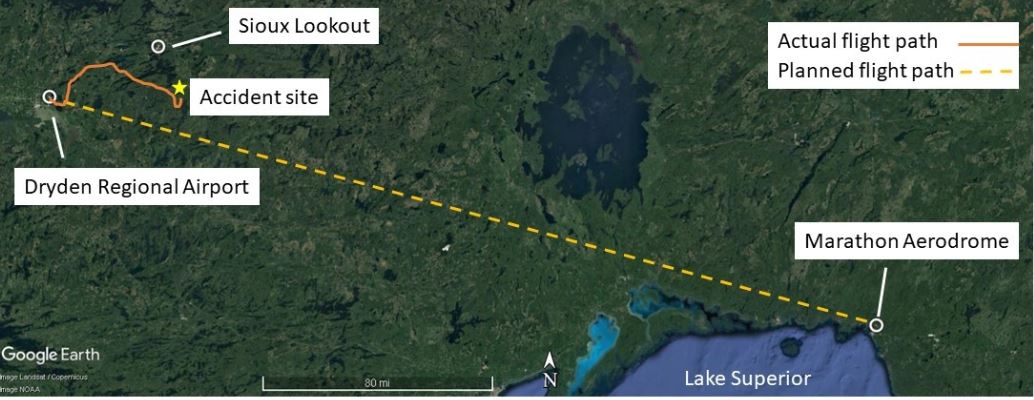
Winnipeg, Manitoba, 14 November 2022 — Today, the Transportation Safety Board of Canada (TSB) released its investigation report (A22C0027) into the 29 April 2022 fatal collision with terrain involving a privately-registered Piper PA-28-140 aircraft near Sioux Lookout, ON.
The TSB conducted a limited-scope, class 4 investigation into this occurrence to advance transportation safety through greater awareness of potential safety issues. See the Policy on Occurrence Classification for more information.
The TSB is an independent agency that investigates air, marine, pipeline, and rail transportation occurrences. Its sole aim is the advancement of transportation safety. It is not the function of the Board to assign fault or determine civil or criminal liability.
Air transportation safety investigation report A22C0027
Loss of control and collision with terrain
Privately registered
Piper Cherokee PA-28-140, C-GLKD
Sioux Lookout Airport, Ontario, 19 NM SSE
29 April 2022
The Transportation Safety Board of Canada (TSB) investigated this occurrence for the purpose of advancing transportation safety. It is not the function of the Board to assign fault or determine civil or criminal liability.
History of the flight
At 2102Footnote1 on 29 April 2022, the privately registered Piper Cherokee PA-28-140 (registration C-GLKD, serial number 28-23807) departed Dryden Regional Airport (CYHD), Ontario, bound for Marathon Aerodrome (CYSP), Ontario, with 1 pilot and 3 passengers on board. The aircraft was reported overdue at 0139 on 30 April 2022. The aircraft had last been observed on radar at 2145,Footnote2 flying a zig-zag route over an area with limited cultural lighting (Figure 1). A search was initiated and the wreckage was found approximately 19 nautical miles south-southeast of Sioux Lookout Airport (CYXL), Ontario. The aircraft had impacted terrain in a wooded area during the hours of darkness. The pilot and 3 passengers were fatally injured. The aircraft was destroyed. The emergency locator transmitter (ELT)Footnote3 activated on impact and the signal assisted search and rescue services in locating the accident site.

Pilot information
The pilot held a commercial pilot licence, which had been issued on 18 September 2019. His licence was endorsed for single- and multi-engine aircraft. He held a valid Category 1 medical certificate. He did not have an instrument rating; therefore, he was not qualified for flight in instrument meteorological conditions (IMC).
In accordance with the Canadian Aviation Regulations (CARs), the holder of a pilot licence is required to have completed 5 night takeoffs and 5 night landings within the 6 months preceding the flight to fly an aircraft with passengers on board at night.Footnote4 The investigation reviewed the pilot’s logbook and did not identify any night flight entries in the 6 months preceding the accident.
The passenger who was seated in the front right seat also held a commercial pilot licence.
Aircraft Information
The occurrence Piper PA-28-140 was manufactured by the Piper Aircraft Corporation in 1967. It was a single-engine, all-metal, low-wing aircraft, equipped with fixed tricycle landing gear. It was configured to carry 4 passengers and was certified for a maximum take-off weight of 2150 pounds. The aircraft weight at the time of the occurrence was calculated to be approximately 2320 pounds, which is 170 pounds over the aircraft’s maximum take-off weight.
The aircraft was privately registered and maintained on an annual inspection program as specified in CARs Standard 625.86, Appendix B, Part I. The aircraft had undergone a 50-hour inspection on 08 March 2022 and had a total airframe time of 4467 hours at the time of the occurrence.
The aircraft was originally equipped with a 150 hp Lycoming O-320-E2A carbureted engine. In March 2019, the engine and aircraft were modified to achieve an increased take-off power rating of 160 hp, under the authority of Supplemental Type Certificate numbers SE8987SW-D and SA2706SW-D, respectively.
A review of the aircraft technical records did not reveal any outstanding defects that may have contributed to the occurrence.
Impact and wreckage information
The aircraft struck trees in a heavily wooded area approximately 19 nautical miles south-southeast of Sioux Lookout, Ontario. The investigation determined that the aircraft entered the forest canopy in a 90° angle of bank, indicating that it had departed controlled flight. The aircraft came to rest approximately 100 feet from where it initially came into contact with trees. There was no post-impact fire.
The airframe broke apart in a manner consistent with a cartwheeling motion, and both fuel cells ruptured. Analysis of the aircraft components did not reveal any pre-existing anomalies and the engine was determined to have been operating normally. An inspection of the carburetor heat selector was inconclusive due to the nature of the impact damage. While the investigation did not reveal any signs of carburetor icing, the local weather conditions were consistent with those that could produce carburetor icing.Footnote5 Damage to the flight controls were consistent with overload failures, also a result of the impact.
You must be logged in to post a comment.